Automated email workflows can net you 20% more sales opportunities.
They’re more personalized, timely, and targeted.
The problem, is that the vast majority of marketers – as high as 85% – are unhappy with their performance.
Not the results of those campaigns. But of their own execution or implementation of them.
Instead of rehashing the same onboarding campaigns from the same companies that others have covered well, I spent a Sunday morning digging through my inbox to find examples from different industries. (Sounds like a fun weekend, right?!)
The objective, was to pick out different campaigns at random that were each utilizing different personalization techniques to give you a fresh approach and hopefully inspire new ideas.
Here are seven (plus one special bonus) to emulate, research, and try for yourself.
1. Time Etc. Specific Task Spotlight
Tell me if this sounds familiar.
You find (or hear) about a new amazing service.
First pass, it looks awesome. So you sign up, mess around for a few minutes, and… ?
You hit a wall. A blank. And you’re not sure what to do next.
There’s a reason the vast majority of free trials (~50%) don’t turn into free accounts. People aren’t sure what to do next, and they haven’t seen that ‘first win’ yet.
UK-based, virtual assistant service, Time Etc., sends an early task or feature highlight to new sign-ups who haven’t used the service yet. The goal is to avoid this decision fatigue by helping to prompt people with specific ideas for what to do next.
For example, this one focuses on creating a new repeating task.
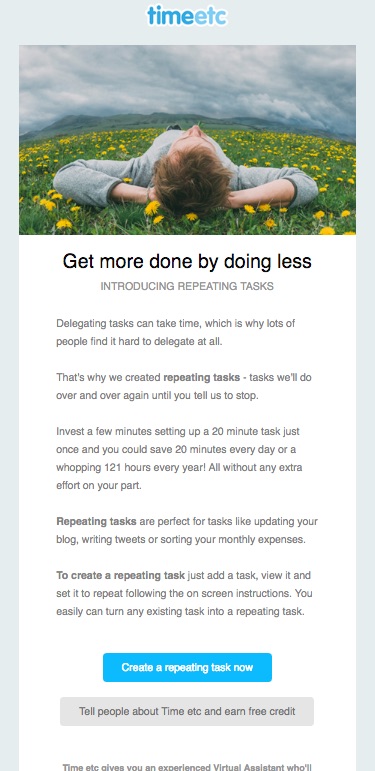
The single column email is just long enough to provide context to a user, before expertly using a primary (create the task now) and secondary CTA (learn more) to get started.
The hope, is that these leading emails can jog some ideas in those reading it, getting them thinking about ways around the initial problem that blocked them from taking the first critical step in the first place.
2. Rock & Roll’s Event Repurchases
The Rock & Roll Marathon Series has grown from humble beginnings in my beloved San Diego, to now stretching out across most major U.S. (and some European) big cities.
They now regularly feature 30,000+ attendees running urban courses with bands, DJs, and more every mile or two of the half and full marathon routes.
As anyone’s who’s thrown an event can tell you, they rely heavily on early sign-ups (even at discounted prices) and repurchases (from past happy attendees) to help forecast and make up for the fact that most will wait until the very last second (and they’ve already shelled out the money to organize everything upfront).
That brings up two key segmentation features:
- By Location
- By Event
Let’s start with the basics:
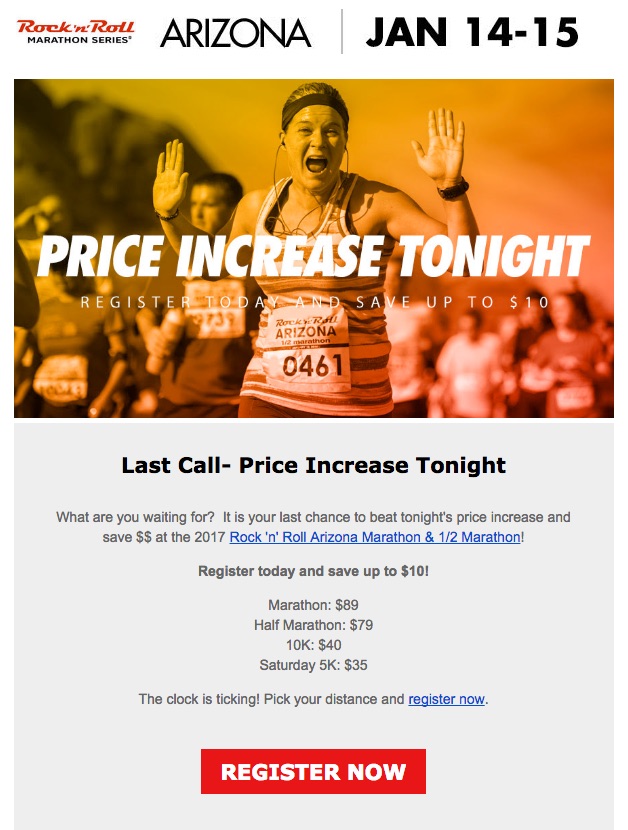
The first example highlights a simple event segmentation, sending a scarcity-based promotional message that would make even Cialdini happy.
This one’s relatively straightforward, relying on the urgency of an early pricing discount expiring to be the entire messaging.
The second is slightly more nuanced.
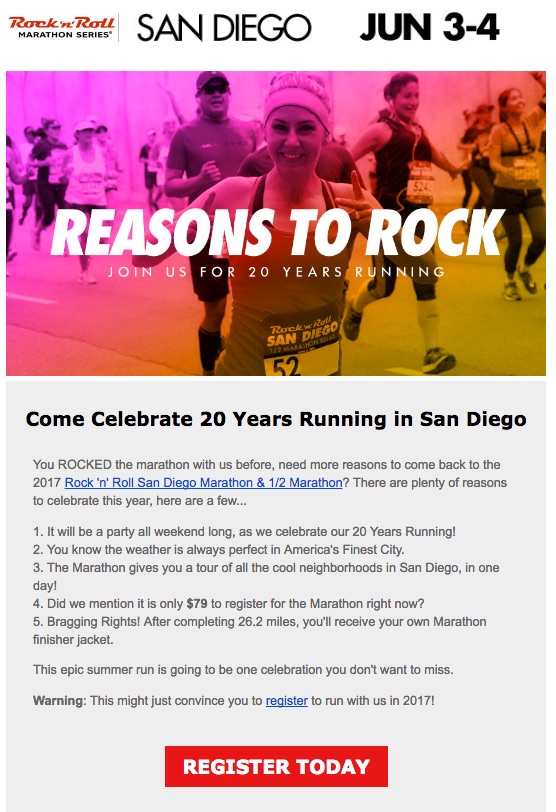
This one is pulling in the (1) event and (2) location details to inspire (and hook) those who just completed that specific event in that specific city to repurchase.
Receiving these, in a succession of months, with the aforementioned urgency-based price increases, are like a war of attrition that slowly but surely whittles away a large list to capture as many early purchases as possible.
This example, along with the Time Etc. one before it, was relatively basic time sensitive examples (where campaigns are sent X days out from Y trigger).
Time to get a little more sophisticated.
3. Expedia’s Recent Booking Abandonment
A hotel booking process is no different than an eCommerce checkout one when you think about it.
A sample of people begin the process, selecting dates (like products) to see how much the grand total might be, before getting distracted (or jumping over to a different product or website to compare prices) and leave the site.
The statistics are also (unfortunately) similar. While as many as 67% of eCommerce people might abandon a cart, 81% of people booking a hotel or travel might bounce as well.
The good news is if this user’s logged in, you can track and react.
Case in point: Expedia sends these behavioral, event-based messages shortly after searching for hotels in specific locations.
The first example pulls in the specific city name in the subject line of the email, while the body copy tends to be a little more generic, focusing on the ‘upsell’ of booking an entire package vs. just selecting a hotel.

The second, features a subject line that’s almost an exact carbon copy of the first (complete with personalized city-name).
However this time, the second one also features a customized message that personalizes the (1) headline, the (2) body copy, and the (3) CTA.
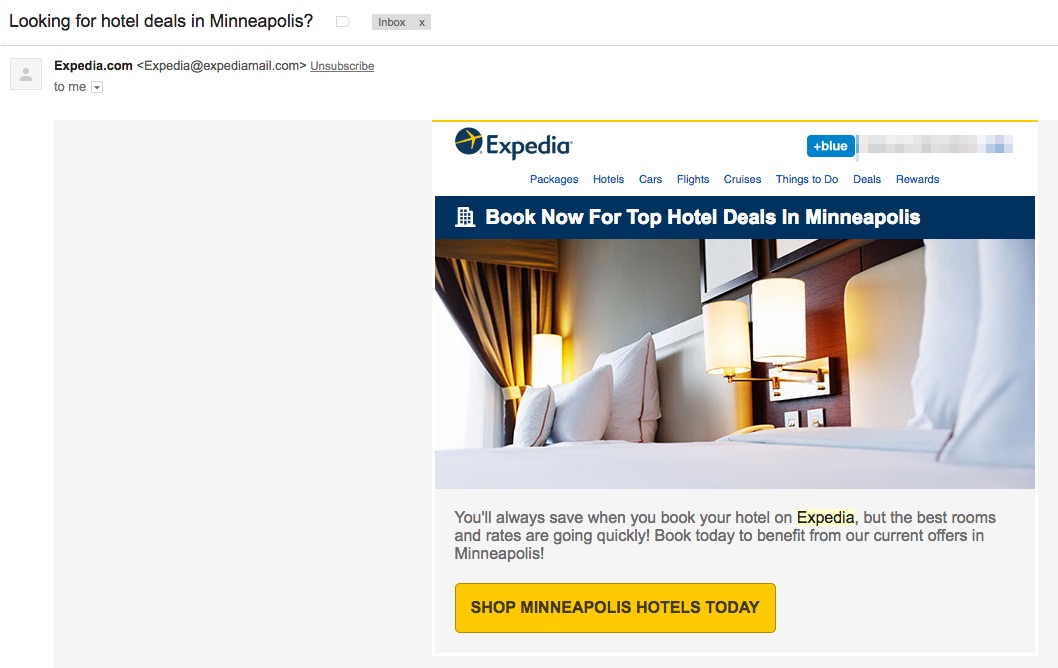
This campaign successfully executes on message match; aligning what a user was just thinking about and doing on your site with the subject line (that will get their attention), and the email content (to get them to click).
4. Ramit’s Warm-Up to Pre-Sell
There’s one sure-fire way to learn from other marketers:
Ignore what they say, and watch what they do.
Some of the best digital marketers pull off a sleight-of-a-hand like a Vegas magician; distracting you with one thing over here while they’re really laying the groundwork for a powerful move later in the act.
There’s no better example of this than Ramit Sethi.
Subscribe to his email list (with a different email or at least some kind of filter) and watch the magic literally unfold.
You’ll get tons (and tons and tons and tons) of text-based emails that do everything from grab attention, to engagement and trust building, before finally witnessing these brilliantly executed sales emails.
First, you’ll be pre-segmented based on what offer (or where on the site) you opted in. Then you’ll receive a mix of content that will switch from the regular ongoing stuff to more choreographed sales efforts.
Typically you can see these coming with an anticipation-inducing “Day 1/X” in the subject line. The copy itself will start layering in social proof (like the number of comments, the number of emails, etc.) before closing with a specific call-to-action to get the reader from passive-to-active.
Here’s one good example:
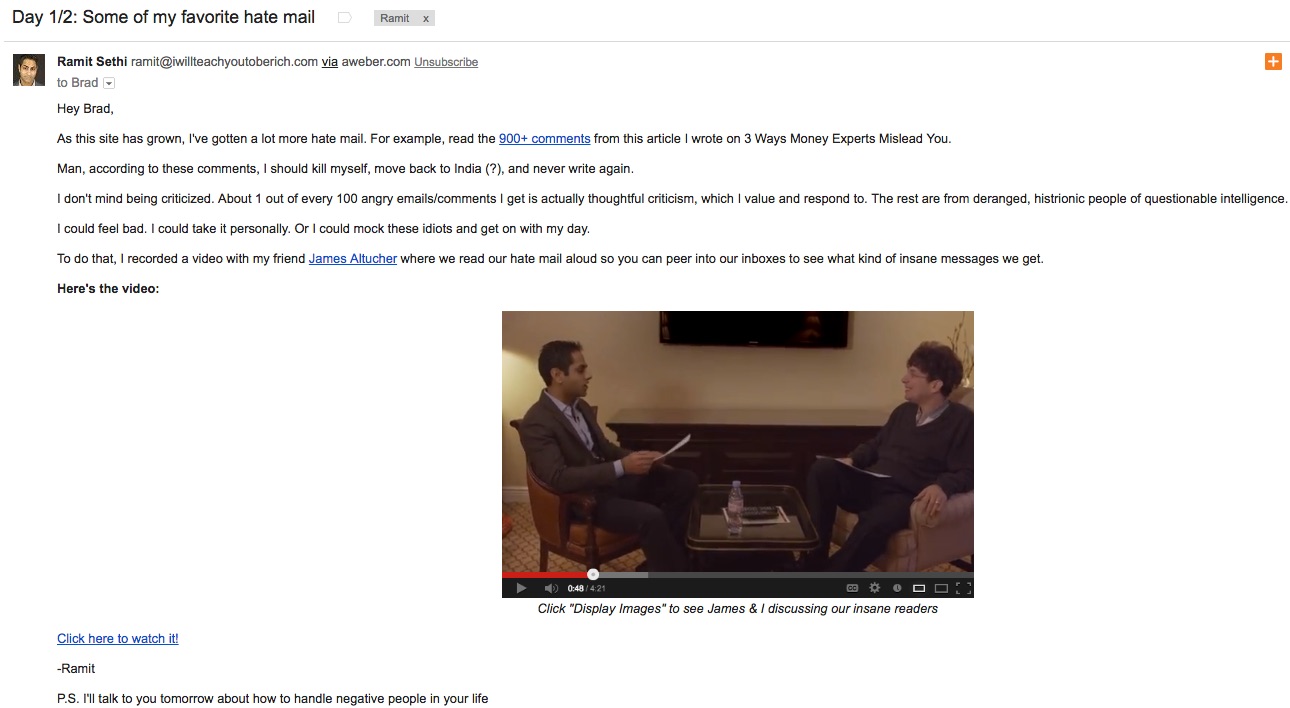
These start out slow. But watch how they build over the course of a few days (to a few weeks for the larger ones), increasing frequency by as much as 2-3 emails per day and altering the messaging based on if you don’t respond, open, or click.
Watching how Ramit seamlessly transitions from focusing on problems and pain points to eventually providing a solution for those should help you not only rethink your email strategy, but all of your content marketing efforts too.
5. Audible’s Proactive Churn-Reducing Outreach
Subscription-based services can be profitable. But it usually takes a few months.
They’re capital intensive businesses, that require you to front-load cash into soft costs (like salaries, etc.) and hard ones (like advertising, etc.) to acquire customers that pay a little at a time (hopefully turning cash-flow positive within a few months).
A churn rate of 5-7% might be acceptable, but anything greater can quickly send your profitability into a tailspin at an accelerated rate (working almost like negative leverage – see: Bear Stearns).
Audible does a good job sensing or predicting churn and proactively responding to hopefully avoid it.
This promotion gives away something with a high perceived value (even though giving away an extra digital copy of something costs, well, air) to ‘win-back’ a customer’s attention.

Highlighted in fine print at the bottom, you can see how they’re pulling out a segment of people to receive this special offer (unused credits as of a certain date).
It’s simple, but effective.
6. Mint’s Important Win-Back Notification
Mint’s another subscription-based service, however they don’t charge consumers anything up front (instead relying on partnerships, revenue shares and affiliate deals).
That means they really need a sticky model that keeps people for months on end.
Deciding to take out a loan, or switch credit card companies, isn’t a decision most consumers make lightly.
They also have this uphill battle at getting people to understand or recognize the problems Mint wants to help you solve (so they can get paid) – when that consumer’s need awareness often doesn’t exist in the first place.
So… how?
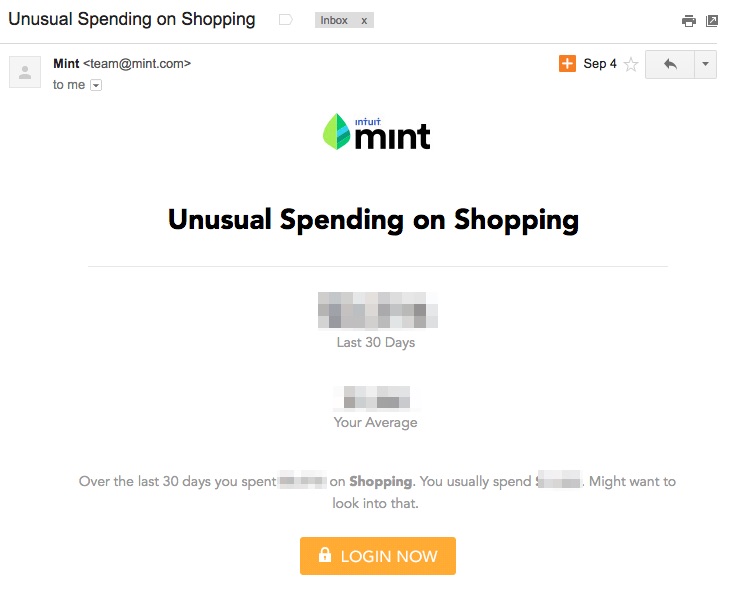
Mint tracks your personalized, historical averages and then sets up notifications or alerts when new aberrations pop up.
Some categories, like spend more on Travel, might be ignored because people are generally delighted to spend there.
However highlighting other frivolous ones, like Shopping, bring up all sorts of insecurities and question marks in someone’s head.
The subject line and matching headline act like a cliffhanger; introducing the problem with a suspicious ‘power word’ (“Unusual”) before directing people to the road to salvation (that big, bright orange “Login Now” button).
7. Salesforce’s Trial Expiration Sequence
We’ve already looked at the dismal statistics of free trialers to paying customers. So let’s jump straight into the examples.
This sequence of three emails is being sent to based on the classic example: user (me in this case) logins in on the first day, before eventually failing to login back in or use the product over the next week of the free trial.
So midstream, Salesforce picks up on this and hints at it with the opening line of the email (“I’m guessing you’re swamped”).

The messaging around it goes for the soft-sell, trying to elicit some response or engagement of any kind so they can intervene and get you back into the product.
The personalized approach, design, and tone also help make it easy (and low-stress) for someone to reach out and get help (as opposed to ‘be sold’).
After not responding for a few days, the tone switches to a more direct, hard sell.
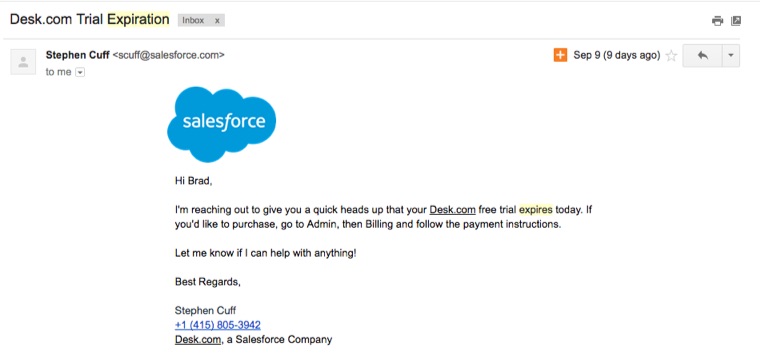
Again, the same personalized style is used to get that one-to-one interaction. But this time the language is less friendly and more business (relying on scarcity yet again to drive action).
A few days later (after again not responding), a more generic re-engagement campaign goes with a ‘action required’-style subject line, and a message that lets you know there’s still time to recover your account and information.

Bonus: Inbound’s Personalized Scale Outreach
Each of the examples listed above incorporate clever segmenting and behavior-based techniques to scale personalized emails.
However one of my favorite (and most thought-provoking) examples comes from Inbound.org and Ed Fry that takes this to new extremes.
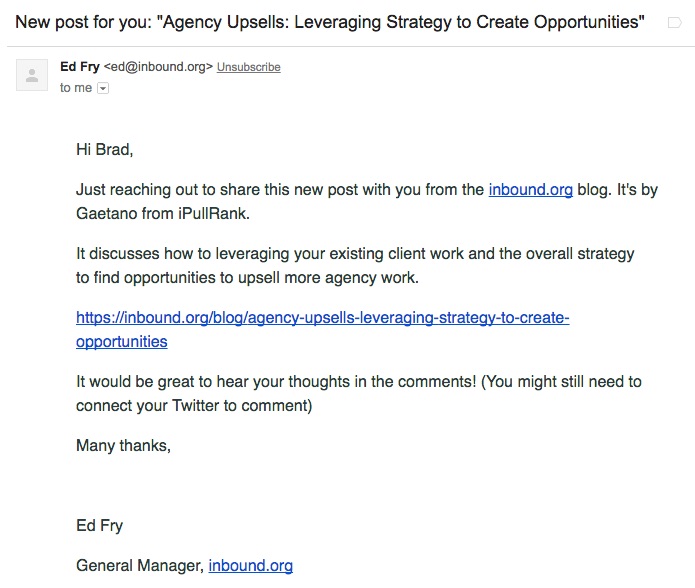
Inbound.org is a community-based site, which is completely dependent on members (of said community) logging in frequently and supplying it with content (posts, answers, interactions, etc.).
The above email incorporates extreme personalization at scale, using:
- My name
- My job title / profession (agency)
- My level of profile completeness (whether my Twitter is connected)
- My engagement (inserting these in between and other emails I receive from them)
Fortunately, Ed was kind enough to share his experience (and results) in running these personalized campaigns.
Ed likened these emails to multivariate tests (as opposed to a more general email campaign), because so many variables are at play within a single email (including the question being asked, the targeting, the messaging, and the lists being selected).
Unsurprisingly, incorporating as much specificity as possible reportedly resulted in the best engagement. So they would test subject line & messaging like:
- Can you help Casey?
- Can you help Casey’s client?
- Can you help Casey’s PPC client?
In order to create campaigns like this, you need a vast amount of customer data (along with the ability to create specialized lists quickly). Here’s a sample of what they used to run these:

This extremely personalized approach is time consuming and complicated to pull off. But the results show extreme promise, too.
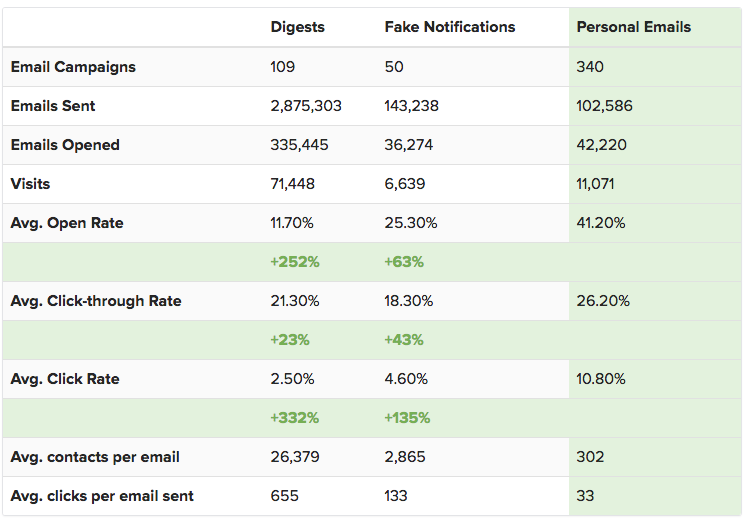
Conclusion
Average website conversion rates are a depressingly low 3% in most industries.
Automated email workflows can help dramatically… assuming you’re going above-and-beyond the basic, Hey $FNAME.
Instead, some of the best combine nurturing, timing, urgency, scarcity, and extreme personalization to break through the noise, get opened, and get clicked.
Use these seven (+1) examples as a starting point to analyze where your own are falling short, and a model for new techniques to experiment with going forward.
The glass half-full version, is that we have a lot of room for potential.
If the final Inbound.org example is anything to go off of, it’s that most of us are still scratching the surface of truly personalized, data-driven techniques that work.
About the Author: Brad Smith is a founding partner at Codeless Interactive, a digital agency specializing in creating personalized customer experiences. Brad’s blog also features more marketing thoughts, opinions and the occasional insight.